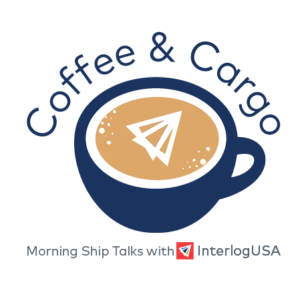Competitive Edge
October 20th, 2021
Stay Current with Interlog’s Weekly Newsletter:
Sign up for our next Coffee & Cargo webinar –> CLICK HERE
Ocean Freight Market Update
Europe –> North America:
Terminal Congestion at Savannah: VERY tight, many lines steering away from Savannah at this time. Continual congestion at LGB is also an ongoing issue. Please contact us for rerouting options.
Rates: Expecting rates to stay consistent the rest of Q4.
Space: Very tight/critical
Capacity: Tight – inland ports are a bit better, however main ports still are having equipment shortages.
TIPS: With capacity tight, it is recommended to book on premium services. Recommend to book 4-5 weeks in advance. Rerouting options away from Savannah are highly recommended.
North America –> Asia:
Rates: November GRI expected, focused on reefers.
Capacity: Steady for Standard Containers, space becoming more available.
TIPS: Looking into re-routing options may be helpful to avoid port congestion at LGB and OAK. Booking 4-6 weeks in advance is recommended to secure equipment and space.
Asia -> North America
Rates: Premium rates are steady, no GRI predicted as rates remain trending downwards. No clear path for how low rates may go or if this is a new ‘constant’. Demand is lower than previous weeks which aids in rates decreasing.
Space: Very tight with long docking wait time at LGB.
Equipment Availability: near-normal conditions, except limited 45HC availability.
TIPS: Savannah Port is critical for port congestion, avoid Savannah and LGB until further notice.
Did You Know?
90% of the world’s goods come and go via ocean freight.
Freight News
What are some reasons for America’s Supply-Chain Shortcomings?
Shelves are looking scarce in many U.S. stores with shortages of every product you can think of. Prices are going up and delays are increasing, so what are some of the reasons for America’s supply chain shortcomings?
Consumer demand increasing: When the pandemic first began, everyone knew there would be delays and shortages, among a countless number of other issues, but no one truly realized the impact the pandemic would have overall. Consumer demand was going down, up until the end of the summer of 2020, then an uptick in consumer spending began, and continued to grow and grow since. Consumer demand is a good thing; however, it’s been difficult for supply chains to keep up.
Lack of workers: The truck transportation industry has felt an immediate impact as the industry has lost 6 percent of its pre-pandemic labor force, over one and a half million workers, according to the Bureau of Labor Statistics. Another issue has been the lack of vaccinations in the global supply chain as many factories have had to suspend operations due to outbreaks and government lockdowns.
Shipping container shortage and clogged ports: Empty containers continuing to pile up in all the wrong places. Some of the reasons for this are lack of workers, complicated customs procedures, amongst a variety of additional problems, according to Maritime Executive. Now, over 60 container ships are anchored in the ocean along the ports of Los Angeles and Long Beach, not being able to unload their items. However, it’s not just those ports that are having this issue, ports are getting clogged all over globally.
The question on everyone’s mind is when will these issues subside? Unfortunately, it is expected for these issues to continue well in 2022.
Container Ship Owners seeing an increase all through 2022
It looks like inflation will continue to persist into 2022 as demand for container ships will not be ending anytime soon. Price liners that are willing to pay to lease ships reflects the degree they need vessels to carry cargo and IF there is a ship left to lease, the rates are astronomical, reported by Freightwaves. Many executives that were on the panel for Capital Link’s New York Maritime Forum in early October spoke on evidence showing liner confidence in high freight rates through 2022, and possibly beyond. CFO of Danaos Corp., Evangelos Chatzis says, “Liners are rushing to fix [charter] tonnage even a year before the current charters expire for four or five years [duration],” reported by Freightwaves Chatzis also mentioned that liners are frontloading lease payments in the first year of multiyear charters.
Many experts are expecting that COVID-related supply chain disruptions on the export side to continue, which will continue to extend backlogs, which will in turn impact vessel demand. Aristides Pittas, CEO of Euroseas says the biggest problem isn’t the ships, its trucking and containers and factories. Everything is like a snowball effect right now and the impact is affecting the entire industry all together.
Sign up for our
industry answers
Our team works to provide valuable, unique, and relevant content to assist you in finding solutions. Sign up now.

